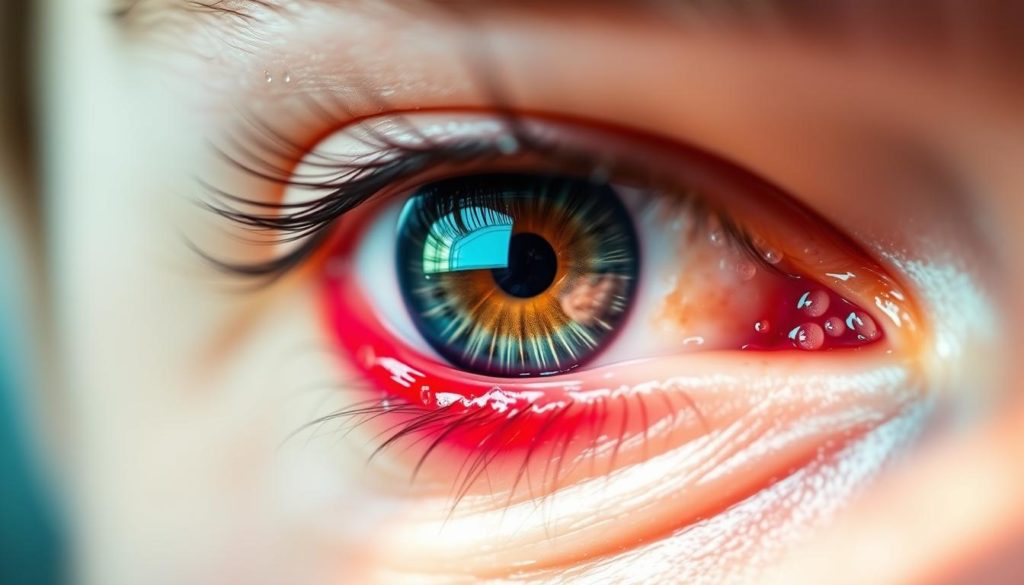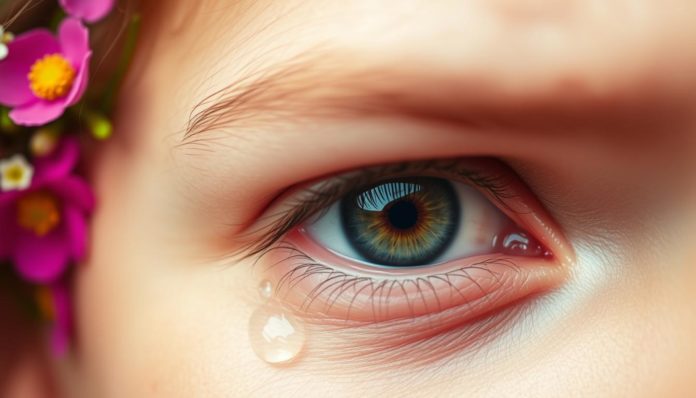Did you know that almost half of people in the U.S. might get allergic conjunctivitis? This condition, often called pink eye, is a big deal. It can really change how you live day to day. It comes from allergens like pollen or animal fur. Though it’s not spread from person to person, it sure can make you feel bad.
Common signs of eye allergies are redness, watering, and itchiness that usually hit both eyes. You might also get puffy eyelids and have trouble seeing clearly. These issues can make everyday tasks hard. But don’t worry, there are many ways to find relief. Things like doctor-prescribed antihistamines or even a cold cloth on your eyes can help. Knowing what helps can make a big difference.
Understanding Allergy Conjunctivitis
Allergy conjunctivitis, often called allergic pink eye, is when the conjunctiva gets irritated. This conjunctiva is a thin layer that covers the white part of the eyes and the inside of the eyelids. Symptoms like itching, redness, and tearing happen mainly if the eyes touch allergens. Pollen, dust mites, or pet dander are common triggers. Knowing what causes allergic pink eye, its symptoms, and how to treat it is key to control it well.

What is Conjunctivitis?
Conjunctivitis, or pink eye, is when the conjunctiva becomes inflamed. This can happen due to infections or allergies. Allergic conjunctivitis comes from an immune response to allergens, causing symptoms like red eyes, swelling, and discomfort.
Causes of Conjunctivitis
Different factors can cause conjunctivitis. In cases of allergic pink eye, things like pollen, dust mites, or pet dander set off allergic reactions. These allergens make the conjunctiva inflamed and irritated. It’s important to understand these causes to prevent and handle allergic pink eye.
| Common Allergens | Description |
|---|---|
| Pollen | Tiny grains released by plants, commonly causing seasonal allergies. |
| Dust Mites | Microscopic organisms found in household dust, often leading to perennial allergies. |
| Mold Spores | Fungi growing in moist environments, contributing to indoor allergy symptoms. |
| Animal Dander | Microscopic flakes of skin shed by animals, a potent allergen for many individuals. |
Symptoms of Allergy Conjunctivitis
Allergic conjunctivitis, or pink eye, has various symptoms. These can disrupt daily life. Knowing these symptoms helps tell it apart from other eye infections.

Common Symptoms
Common symptoms include:
- Redness in the whites of the eyes
- Intense itching
- Watery discharge
- Swollen eyelids
- Potential nasal issues such as sneezing and congestion
These symptoms can change in how severe they are. But they often greatly affect comfort and vision.
Seasonal vs. Perennial Symptoms
Knowing the difference between Seasonal and Perennial symptoms is key. It helps in managing them well.
| Type | Description | Common Triggers |
|---|---|---|
| Seasonal Allergy Conjunctivitis | Occurs during specific seasons | Pollen, grass, and other outdoor allergens |
| Perennial Allergy Conjunctivitis | Present year-round | Indoor allergens such as pet dander and dust mites |
Understanding this helps in picking the right treatment and prevention. This lets people handle their symptoms better all year.
How to Diagnose Allergy Conjunctivitis
Diagnosing Pink Eye, especially when it involves allergies, starts by looking at the symptoms and doing an eye exam. Symptoms of allergic conjunctivitis include clear discharges and a lot of itching. It’s important to tell it apart from viral infections because the treatments are different.
For an accurate diagnosis of allergic conjunctivitis, doctors may carry out Eye Allergy Testing. They start by checking your medical history. Then, they may do skin or blood tests to find the allergens causing your symptoms.
| Diagnosis Step | Description |
|---|---|
| Symptom Review | Identification of clear discharge and eye itching. |
| Eye Examination | Professional check-up to distinguish between viral and allergic conjunctivitis. |
| Eye Allergy Testing | Skin or blood tests to detect specific allergens. |
- Diagnosing Pink Eye with allergies involves identifying clear discharges.
- Professional Allergic Conjunctivitis Diagnosis is essential for proper treatment.
- Performing Eye Allergy Testing can pinpoint the causative allergens.
Understanding how to diagnose allergic conjunctivitis correctly makes a big difference. It helps in managing and treating the condition effectively.
Treating Allergy Conjunctivitis (Pink Eye)
To effectively treat allergic conjunctivitis, combine medications with simple home remedies. We’ll dive into various ways to ease this condition.
Prescription and Over-the-Counter Medications
Many options exist for treating allergic conjunctivitis. Topical decongestants and antihistamines help lessen redness and itchiness. In tough cases, doctors may suggest steroids or other medications.
For ongoing care, immunotherapy might be used to attack the allergy’s cause directly.
Effective Home Remedies
For relief from pink eye, several simple home cures work well. Consider trying:
- Applying cold compresses to ease swelling and discomfort.
- Artificial tears to moisten and calm irritated eyes.
- Keeping clean by washing hands often and not touching your eyes.
- Staying away from allergens to keep symptoms at bay.
Always talk to a healthcare provider before starting or changing your treatment. This ensures safety and effectiveness.
Preventive Measures for Allergy Conjunctivitis
To reduce the risk of allergy conjunctivitis, taking preventive steps is key. Avoid allergens and keep clean to help prevent eye allergies.
Allergen Avoidance
Avoiding allergens helps prevent allergic conjunctivitis. To reduce allergens:
- Use allergen-proof bedding to cut down on dust mites.
- Wash bed linens in hot water to get rid of allergens.
- Use air filters to catch airborne particles in your home.
- Avoid eye makeup that can hold onto allergens.
- Stay inside when pollen counts are high.
Hygiene Practices
Keeping good hygiene is important in fighting allergic conjunctivitis:
- Wash your hands often to keep allergens away from your eyes.
- Avoid sharing eye care items like towels and makeup.
- Take care of your contact lenses by cleaning and storing them correctly.
By following these steps for avoiding allergens and staying clean, you can greatly lower your chances of getting allergic conjunctivitis.
Differences Between Viral and Allergy Conjunctivitis
It’s important to know the Pink Eye Differences for the right treatment and to stop it from spreading. There are two main kinds: viral and allergic conjunctivitis. Each shows different signs and behaviors.
Viral Conjunctivitis spreads easily, often moving from one eye to the other. Its signs include a clear or white eye discharge. People usually feel a mild discomfort rather than severe itching. This condition comes from infections, like the common cold, not from allergies.
In contrast, Allergic Conjunctivitis comes from allergens like pollen or pet dander and it doesn’t spread to others. Typical signs are itchiness, redness, and teary eyes in both eyes. It’s seen with seasonal allergies. Treatments include antihistamines.
| Key Characteristics | Viral Conjunctivitis | Allergic Conjunctivitis |
|---|---|---|
| Contagiousness | Highly contagious | Not contagious |
| Main Symptoms | Clear/white discharge, mild discomfort | Intense itching, redness, watery discharge |
| Causative Agents | Viruses (e.g., common cold) | Allergens (e.g., pollen, dust mites) |
| Usual Onset | Starts in one eye | Affects both eyes simultaneously |
Knowing the differences between Viral vs. Allergic Conjunctivitis is key. It helps pick the right treatment, leading to faster recovery and stopping it from spreading or causing pain.
Role of Immunotherapy in Managing Pink Eye Allergy
Learning about immunotherapy for Pink Eye is key for those with allergic conjunctivitis. It’s really good for those who often get severe Pink Eye. The treatment focuses on the immune system’s reaction, which causes the problem.
Allergy shots are a main way of treating eye allergies with immunotherapy. Check out more about it here. These shots lessen how much the immune system reacts to allergens. That means symptoms can get better for a long time. For any kind of allergic conjunctivitis, allergy shots for Pink Eye are proven to work well.
| Allergy Therapy | Description | Benefits |
|---|---|---|
| Immunotherapy | Gradual exposure to allergens through injections | Long-term relief and reduced allergy sensitivity |
| Topical Antihistamines | Medications applied directly to the eyes | Immediate relief from itching and redness |
| Mast Cell Inhibitors | Prevent release of allergy-causing chemicals | Reduced frequency and severity of flare-ups |
It’s really important to talk to an allergy expert to see if allergy eye treatment like immunotherapy is right for you. Specialists look at your allergy history and needs. They make a treatment plan just for you, to help you the most.
Using Eye Drops for Allergy Conjunctivitis Relief
Eye drops are a great help when you have allergic conjunctivitis. They tackle discomfort from pollen or pet dander allergies. These treatments ease symptoms like itchy, red, and watery eyes. They act fast and target the issue directly.
Many eye drops are out there, each working differently. Antihistamine eye drops block the histamines that cause allergies. Mast cell stabilizers stop these chemicals before they start. It’s vital to follow medical advice when using these to avoid side effects.
Steroid eye drops help with severe symptoms by reducing inflammation. But, they must be used carefully to avoid complications. Artificial tears are great for keeping eyes moist, removing allergens, and stopping dryness. Always talk to an eye care expert to make sure you’re using the best eye drops for your needs.
FAQ
What is Conjunctivitis?
Conjunctivitis, or pink eye, is when the conjunctiva gets inflamed. This is the part that keeps our eyelid and eyeball moist. It’s often due to allergens but isn’t catchy. Symptoms are redness, tears, itchy eyes, swollen lids, and blurry vision, usually in both eyes.
How can I relieve allergic conjunctivitis symptoms?
For relief, you can use antihistamines, stay away from allergens, or use eye decongestants. Lubricants, steroids, and immunotherapy are also treatments. At home, cold compresses and cleanliness help ease the discomfort.
What causes allergic conjunctivitis?
Things like pollen, dust, and mold trigger allergic conjunctivitis. These irritants cause symptoms like redness, swelling, and eye discomfort. It happens when allergens make our immune system react, leading to these issues.
What are the common symptoms of allergic conjunctivitis?
The usual symptoms are severe itching, watery eyes, redness in the whites of your eyes, and swollen lids. You might also sneeze a lot. These symptoms can be either seasonal or last all year, based on the allergens.
How do you diagnose allergic conjunctivitis?
To diagnose it, doctors look at your symptoms and check your eyes. Allergic reactions show clear eye discharges and a lot of itching. Sometimes, skin or blood tests are needed to pinpoint the allergens.
What are some effective home remedies for allergic conjunctivitis?
Effective home treatments include cold compresses and artificial tears. Being clean and staying away from allergens also helps. These methods can reduce symptoms and make you feel better.
What preventive measures can I take for allergic conjunctivitis?
To prevent it, avoid allergens, keep clean, don’t wear eye makeup, and take care of your contact lenses right. Using dust mite-proof bedding, washing linens in hot water, and air filters can also reduce symptoms.
How can I tell the difference between viral and allergic conjunctivitis?
Allergic conjunctivitis means itching and redness in both eyes without being contagious. Viral conjunctivitis usually starts in one eye and can spread. It has clear or white discharge but without the intense itching of allergies.
What role does immunotherapy play in managing pink eye allergies?
Immunotherapy, or allergy shots, help a lot with long-term control of pink eye allergies. It makes the immune system less sensitive to certain allergens, offering relief for a longer time. An allergy specialist can tell if it’s right for you.
Are eye drops effective for allergic conjunctivitis relief?
Yes, eye drops help ease the symptoms. They come in types like antihistamines, mast cell stabilizers, steroids, and lubricants. They offer direct relief for itchy, red, and watery eyes. Always use them as advised by a doctor, especially those with vasoconstrictors and steroids because of potential side effects.


